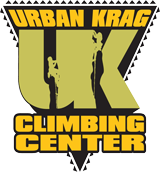Instruction Classes and Video
Available Classes (In Person)
Customers are welcomed and encouraged to arrive 10-15 minutes prior to their class start time. This allows ample time to settle in and be prepared for when the class begins. Instructors typically arrive 30 minutes early to their classes and will be here to allow entry to the facility. Please read and sign the Urban Krag Late Arrival and Rescheduling Policy below.
To schedule any of our instructional classes, please Contact Us with your contact information, the class you’re interested in and the date you’d prefer to take the class. One of our instructors will contact you to work out a schedule with you and answer any questions you may have.
A good rule of thumb is scheduling the class 10 days from you first contacting us. Our instructors also work in the gym so, gym work schedule take priority over scheduling instructional classes.
Introduction to Rock Climbing
Cost: $50 per person
Duration: 2.5 Hrs
Rappelling
Cost: $80 per person
Duration: 2.5 Hrs
It’s a good idea to know how to get down before you go up. Did you know that the majority of climbing accidents occur during a rappel? This technique of getting to the ground can be very dangerous, if not deadly, if simple procedures are skipped or missed. We will teach you proper procedures to safely get you back on the ground.
Sport Climbing
Cost: $80 per person
Duration: 2.5 Hrs
This is lead climbing, the sharp end so to speak. A climber tows the rope along a route and secures themselves into protection installed in the rock. In lead climbing, the climbers falling distance is limited to twice the distance of their last protection. In other words, if the protection is 5′ below the lead climber and they fall, they fall at least 10′. Lead climbing requires keeping your wits about you, strategy, knowing your limits and foreseeing a dangerous situation. This class will teach you those things, including how to Belay a lead climber.
Technique
Cost: $60 per person, per hour
Learn basic and advanced techniques in person.
Instruction and Video (Self Learning)
Knot Tying
Figure 8
Figure 8 (follow through)
Double Fisherman’s
Although the figure 8 is a great knot, everything in climbing has backups, so you should also tie a double fisherman’s knot above the 8. Wrap the rope twice around, coming closer to yourself with each wrap. After the second full wrap, slide the end up through the two loops. Pull this knot snugly; double-check all your knots. You’re almost ready to climb.
Climbing Techniques
Lead Climbing
Bouldering
In bouldering the climber has no rope, no belayer and no harness to hold them up. Our 12 foot angled bouldering wall is great though for climbers to get better experience before the run up one of our larger walls. Bouldering presents it’s own puzzles, though, as the walls are built at various angles and difficulties.
